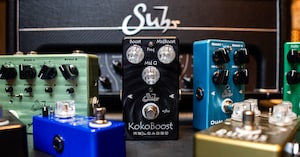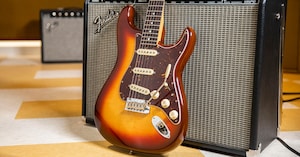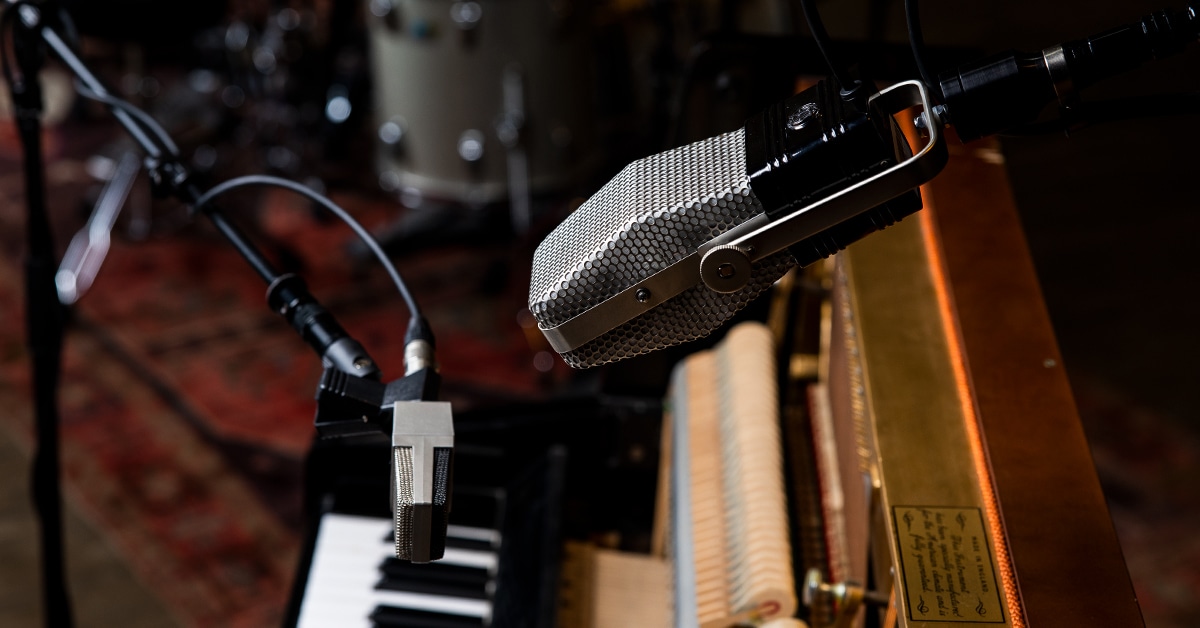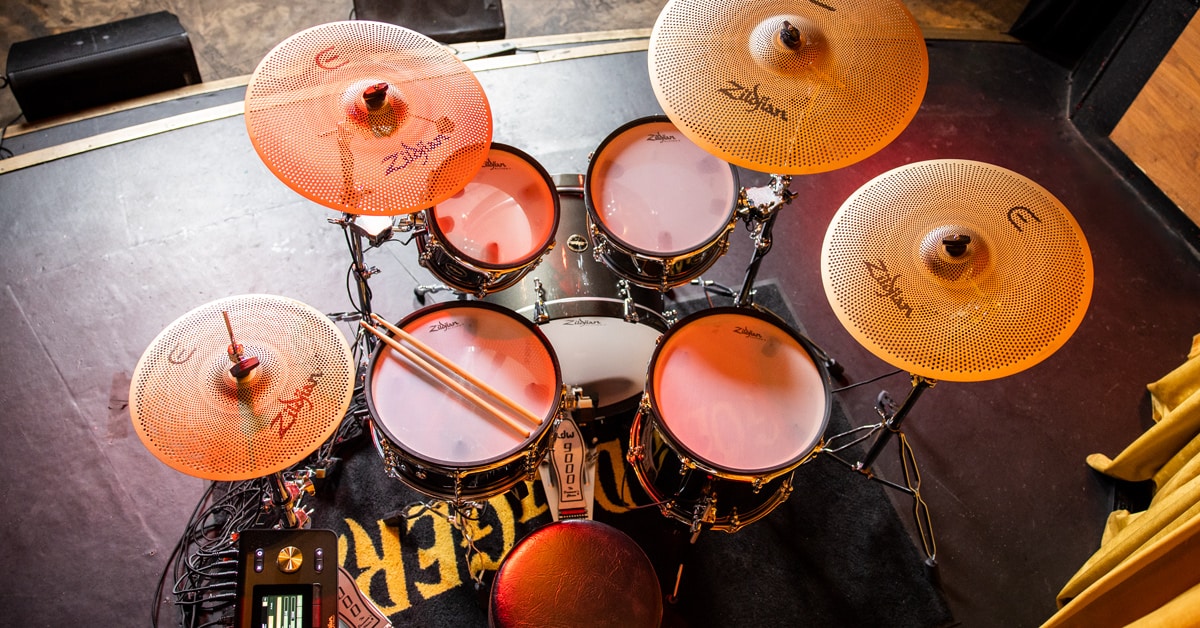Zildjian—the 400-year-old cymbal maker—has debuted three electronic drum kits, the ALCHEM-E Bronze EX, Gold and flagship Gold EX.
We can hear you thinking, “What?”
The development of the company’s first-ever e-kit series is far from a toe dip into a burgeoning market space. Instead, ALCHEM-E is an “all-in” situation where Zildjian plans to unleash its commitment to innovation—as well as its centuries-long experience with drums and drummers—to not just offer a comparable “e-experience,” but to push the sonic, ergonomic and performance boundaries of electronic drumming.
For example, Zildjian E-FAMILY cymbals are not conventional rubber pads. They are genuine, acoustic, low-volume cymbals that deliver the same feel as hitting a metal cymbal—because they are forged from metal. Furthermore, the Zildjian E-VAULT drum module delivers authentic Zildjian cymbal sounds, in addition to a curated library of drum and percussion samples.
There's far more of a story to tell, which includes purchasing Ikuo Kakehashi’s music technology company (Kakehashi is the son of the founder of Roland) and bringing on longtime e-drum specialist Mike Snyder to collaborate with the Zildjian team. So, we’re giving the drum throne to Zildjian Senior Business Manager, Innovation Mike Weber to illuminate all the creative strategies and architecture behind the burning question you may have: Why would a cymbal company build an e-kit with advanced tech and premium wood drum shells?

Pictured: Zildjian ALCHEM-E Gold EX Bass Drum
There are some experienced music tech companies currently making very popular e-drums. Zildjian likely could have been astoundingly successful simply licensing its E-FAMILY cymbals to other brands. What was the motivation and vision to go all-in and manufacture a complete e-kit?
Mike Weber: We had a lot of very long in-depth conversations and game planning—as you can imagine. We considered partnerships with other companies, licensing the tech, or even just launching cymbals on our own and not a full-blown kit. There are a lot of reasons why we chose the path we did, but I think at the very highest level, we wanted to be able to offer a complete experience. The feel, the look, the sound and the brand are a full immersive Zildjian packaged deal. We really wanted to put a stake in the ground to establish ourselves in the e-drum world. Said another way, this is not at all, in any way, shape or form, a one-and-done thing.
We created an entire new division within Zildjian. We call it New Ventures for things outside of our core business of cymbals, sticks, mallets, gear, apparel and accessories. This is merely the first of many innovations you'll see coming out of this group at Zildjian over the next several years.
Getting right into it, what did your team have to do to make sure the cymbal trigger wasn't confused by all the resonance from when you strike the cymbal?
That has been the holy grail for so many years in e-drums. Triggers and sensors work off the impact and the vibration. So, when you have a fully open cymbal that's vibrating at will, it does, like you said, confuse the tech.
Rubber cymbal pads don’t vibrate, so they trigger pretty accurately. But because they don’t vibrate, they don't feel like a real cymbal. You'll even see metal cymbals that have three pounds of dampening stuck to the bottom to control the vibration. Those dampened cymbals trigger okay, but they feel like you're hitting a granite countertop.
The challenge was dialing in the software to be able to decipher exactly where you're hitting the cymbal—and how hard you're hitting it—and yet not react to those unwanted sympathetic vibrations. That’s really the magic of the whole thing. Our overall goal was, “Let's create an electronic cymbal that is virtually indistinguishable from an acoustic cymbal.” This is what we've accomplished with our proprietary software and the technology we developed.

Pictured: Zildjian ALCHEM-E Gold EX E-FAMILY Low Volume Cymbals
How did you pull that magic off? Did you have to bring in someone from a different background of technology to figure out how to do this?
We’ve been the cymbal company for literally 400 years, and we talk about this not being a one-and-done thing. We really did go all in. To accomplish this, we acquired a very talented group of engineers based in Japan. They have a combined experience of nearly 200 years in electronic instrument design. The company was founded by Ikuo Kakehashi, who is the son of the founder of Roland. The team is made up of engineers who worked at Roland, ATV Drums and even Sony. This is the core group of engineers that Roland founder Mr. K handpicked to be his engineering team. That's who we now have on our team.
We knew we needed to find an experienced partner to help our vision for this project come to life, so we decided to acquire them, rather than use them as contractors or consultants. They are now part of the Zildjian family. So, you have this marriage of the Kakehashi family, who built themselves on driving innovation, and the Zildjian family, who also built the company on driving innovation. Together, we really bridge the gap between the acoustic cymbal side and the electronic instrument side. These guys are absolute geniuses and gurus in DSP.
To your original question, you've got the death metal thrash drummer who’s nailing the bell of the cymbal, and then you have the feather touch of the jazz drummer. I think we’ve done our best to create a trigger response out of the box that can cover that whole dynamic. Obviously, no two drummers are alike, so depending on what you play or how you play, the response of the cymbals is infinitely adjustable.
When you start up the module, you select which model you’re playing. We're launching with three models: Bronze EX, Gold and Gold EX. The very next question is, “What's your playing style?” You can choose from light, medium or heavy—which immediately creates a specific trigger profile. You can change the profile at any time, and you can tweak it infinitely beyond that. Everyone has a different feel to their playing, so these trigger presets allow different responses for different drummers.

Pictured: Zildjian ALCHEM-E Gold EX Hi-Hat and Snare Drum
Why did you choose to use low-volume cymbals on these kits, rather than conventional cymbals?
We went through maybe 30 or 40 different prototype cymbals. Initially, we wanted to have a fully dampened acoustic cymbal. They looked good and triggered well because they didn’t vibrate as much. The dampened cymbal made it a little bit easier to do what we wanted to do, but it always just kept coming back to feel. Like I said, playing a fully dampened cymbal kind of feels like hitting a granite countertop or a cinderblock—even when we tried various perforation and hole patterns, as well as trying different placements for the dampening materials.
We tried our Low Volume cymbals—which have been used as realistic-feeling practice cymbals for years. They just feel the absolute best, and we kept coming back to them. So, we got the best trigger performance and playing experience out of those.
Did you do anything different to the Low Volume cymbals for the ALCHEM-E kit, or did you go with the standard models you already manufacture, but with triggers in them?
The E-FAMILY cymbals for Zildjian ALCHEM-E are essentially L80 Low Volume cymbals. There are a couple of different nuances. For example, to accommodate the electronics, the center hole has a slightly different shape for consistency, and the bottom hi-hat has an extra hole for the cable pass-through. There weren’t any major modifications. Because the perforations physically move less air—which is what makes them so quiet—there’s going to be a slightly different feel than if I'm hitting a solid cymbal. But, because of the sizes and the material these electronic cymbals are made from, they are absolutely the closest thing you'll find to playing an acoustic cymbal, because they are acoustic cymbals.

Pictured: Zildjian ALCHEM-E Gold EX E-FAMILY Cymbal Insignia
When you say the Zildjian Trigger System provides “vastly superior sensitivity and response,” as compared to other metal or rubber pads, where did you see the most meaningful areas of improvement?
I mentioned this earlier, but the biggest thing is the feel. There's just something about wood on metal that is ingrained in drummers. Beyond that, I think it's the nuances in the response of a cymbal.
A lot of cymbal pads—rubber or metal—can struggle with things such as quick successive hits at different dynamic levels. Like, if you hit a big crash followed by some light ghost notes, most rubber cymbal pads will not pick it up. Zildjian E-FAMILY cymbals, however, pick up every nuance. It's wild how sensitive they are.
Also, with rubber pads, because they don't vibrate much like we talked about earlier, it can take more effort to get softer dynamics. You're almost hitting the cymbal pad artificially too hard compared to how you would play an acoustic cymbal. Whereas, with just the lightest touch of the tip of a drum stick on E-FAMILY cymbals, it will respond exactly how you'd expect an acoustic cymbal would.
The other thing performance wise is choking the cymbal. Most rubber cymbal pads—and even some metal cymbal pads—have a physical switch on the edge of the cymbal that you have to squeeze just right to get it to choke. It really takes you out of the experience because you have to think about it too much. It's unnatural. Our cymbals use capacitive-touch choking, so it’s exactly like choking an acoustic cymbal. No matter where you touch the cymbal—on the top, bottom, edge, side or even resting your hand on top of it—when the vibration stops, so does the sound. It could not be any more natural. That was another big differentiator as far as performance of our cymbals versus a typical cymbal pad.

Pictured: Zildjian ALCHEM-E Gold EX Snare Drum
What inspired the hybrid quality of ALCHEM-E?
I think it's a great option to have the ability to convert from an electronic kit to an acoustic kit. People love to have options. That said, I imagine most people are going to play it as an electronic kit first—especially once they've got it dialed in and see how much fun it is to sit down and play.
However, it's going to ship with acoustic resonant heads. The Gold and Gold EX kits are seven-ply North American maple—they’re great-sounding, great-looking, great-feeling acoustic drums.
Was the superior sensitivity and response just for the cymbals, or did you do that for the rest of the drums, too?
Obviously, the cymbals are the crown jewel. I think most people would agree that, with electronic kits, the drums have come so much further than the cymbals have. But we still made sure that our drums are incredibly sensitive and fun to play. I can just tap the edge of my fingernail on the snare drum, and you can hear it picking up the sound—just like an acoustic snare drum would. Every drum has three zones, so you can get head, rimshot and rim sounds. In addition, all the triggers are around the edge of the drum, not in the center. As a result, there's a lot less hot spotting and things like that. The drums perform incredibly well.

Pictured: Zildjian ALCHEM-E Gold EX Rack Tom
As you were looking at other e-drums, what did you identify in the module portion of the kits that you thought Zildjian could do uniquely better?
From the very beginning, our goal was to make the module as simple as possible. Drummers want to drum. We didn’t want drummers to have to have a degree in sound engineering to be able to open these kits up and get the most out of them.
In any module—and in any electronic drum set—there's going to be some calibration needed. And something that certainly helps the simplicity of the navigation in ALCHEM-E’s module is the large touchscreen. We tried to design an experience that allows you to engage with the touchscreen—as well as some good old-fashioned physical knobs and buttons—very easily.
You’ve got what we call our workspace, or quick-navigation buttons. These are the four places drummers are going to want to go most often to edit an instrument, the trigger settings and their mix. You can navigate those areas through the touchscreen, but you also have physical dials, because every situation is a little bit different. For example, if I'm sitting at home practicing, I might take the time to reach over and use the touchscreen to adjust my mix or something. But, between songs during the heat of a gig, I want the reliability of turning a knob and loading up the kit for the next tune. We wanted to make sure we gave people both options.

Pictured: Zildjian ALCHEM-E E-VAULT Control Module
Regarding sampling techniques, what did Zildjian do that others have not?
Well, that’s part of the secret sauce! But, at a high level, it's the mics we use and the mic placement. It's the number of times—hundreds of times—we hit each cymbal and drum. It's the editing. It's the mixing. It's the testing. It's the voicing. It's the proprietary software. All of that comes together to give you this very pure, authentic tone.
I mentioned this team of engineers who have been doing this for, well, since e-kits were created. We also brought in Mike Snyder who started in electronic percussion in the ’80s and carved his niche as the e-drum guy. He made his living as a professional drummer and percussionist, got into the world of electronic drums, worked for Roland for a couple of decades, and then was at ATV Drums. We hired him as our product development manager of innovation—specifically for this project, as well as future projects in this space. So, again, this is not Zildjian watching YouTube and saying, “Okay, how do you sample a drum? How do you sample a cymbal?” We brought in people that know this world extremely deeply and have been applauded for the quality and output that they've gotten in the past.
What was the main thing they said as far as sampling?
I think the biggest debate we had, and, honestly, continue to have to a certain degree, is whether to deliver a really natural, raw acoustic tone that can be recorded and mixed later, or provide sounds that already appear like they were on a final mix—with effects and everything—for enjoying playing and rehearsing at home. We erred more on the pure acoustic tone side of things, but we also gave some of the sounds a more produced sound. We know there are those two contingents of players—those who want a natural, “playing in the room” experience, and those who prefer playing something that sounds like it came right off a record. There are different presets, and you can adjust them infinitely yourself.

Pictured: Zildjian ALCHEM-E E-VAULT Control Module Rear Panel
What was the process for deciding which type of E- FAMILY cymbals to do first?
We wanted to cover the key sizes, so that everything was true to life, and provide an immersive acoustic experience. Our best-selling, most popular sizes are 14" hats, 16" crashes, 20" rides and 18" crash/rides. That was really the major decision-maker, and we said, “Let’s go with that.” Of course, it's only natural to expand in other directions, such as Chinas, splashes, stacks and effects cymbals. Those things are on our road map for future development.
Was there a battle in having so many cymbals to choose from during the sampling sessions?
At launch, the selection was a collaborative effort between me as the business manager and the team. First, we prioritized fan favorites and tried to get a good representation—a good breadth—right out of the box. You've got As in there, A Customs, Ks—some brighter sounds and some darker sounds. Of course, we’re Zildjian, and our cymbal catalog is so vast, so we will continue to add more and more cymbals from our assortment in the coming months that will be available for drummers to download and add to their E-VAULT. We're continuing to crank through the editing and sampling process, and we'll definitely update selections post-launch that will be available for drummers to download and add to their E-VAULT. Perhaps we’ll go through the current catalog and then look into the past—vintage stuff, discontinued things, one-off artist prototypes that were never in the catalog and so on.
Who do you feel is the core user for this kit?
It’s interesting you should ask. We say it’s for beginners up to pros. But when you hear the term "beginner," people immediately connotate that with a young kid playing the drums in their parents’ basement. But we've come across so many beginners that are 30 to 50 years old. Maybe they started playing drums in high school, fell in love with it, but then life got in the way. However, they still have that passion burning, and they want the best of the best. So, in this space, “pre-teen beginner” appears to be more the exception than the rule.
At their core, these kits—especially at the higher end with the Gold and flagship Gold EX—are for any drummer who wants the authenticity of an acoustic drumming experience, but with the versatility of electronics. An ALCHEM-E kit could be in a home studio, a lesson studio or a house of worship. We've even had several Broadway drummers excited about the possibilities of using ALCHEM-E in the pit or on stage, where they need the lower volume an e-kit provides, but, again, with the feel of real acoustic drums and cymbals.

Pictured: Zildjian ALCHEM-E Gold EX Electronic Drum Kit
Speaking of “weekend warriors,” setting up e-kits can sometimes be daunting to drummers playing on a three-band bill, as they often need get everything on and off stage within 15 minutes between acts. Does the Zildjian ALCHEM-E kit offer a quick and seamless way to get rocking?
At its core, it's just a drum set, right? It's drums, stands and tom mounts. There’s no overly complicated rack system like a lot of e-drums have. As a drummer myself, I've set up and torn down hundreds of kits in my life—mostly acoustic, but also electronic. And I can tell you, the ALCHEM-E doesn’t take much more work. Set it up like you would set up an acoustic drum kit, plug in approximately 12 cables, and you're off and running. It's really straightforward.










